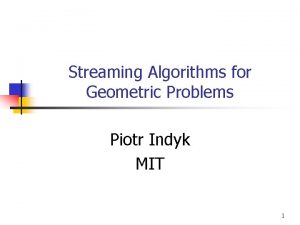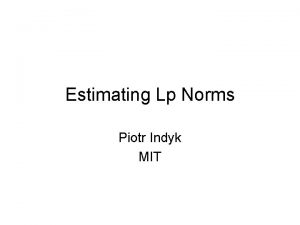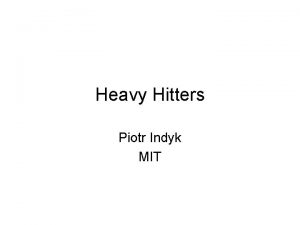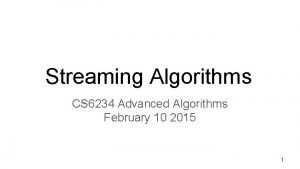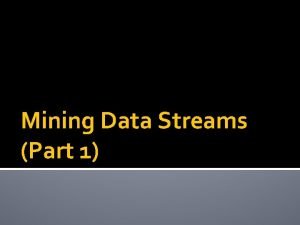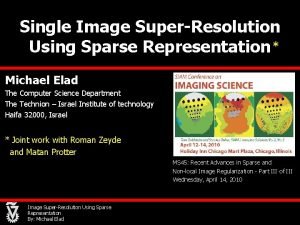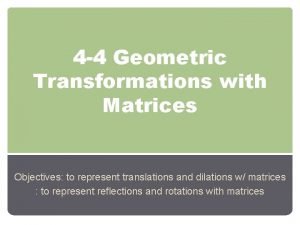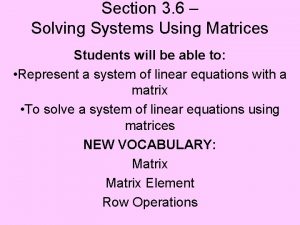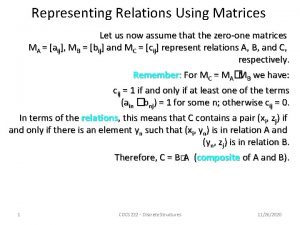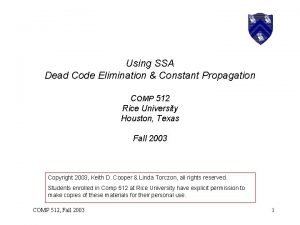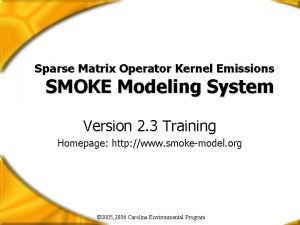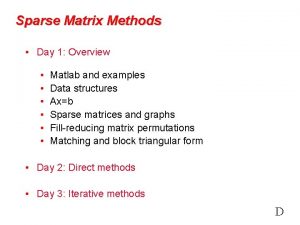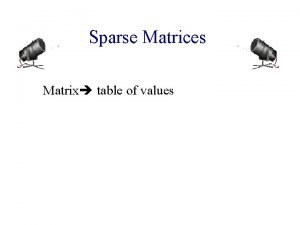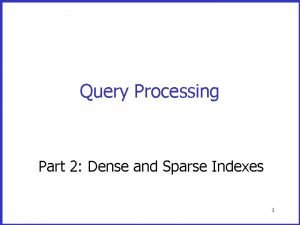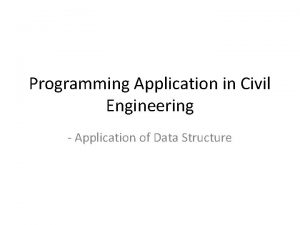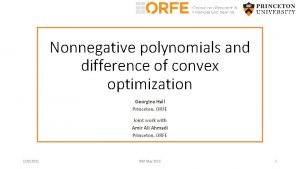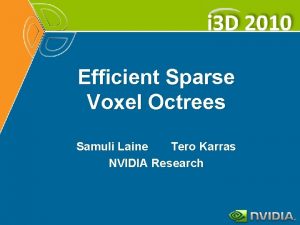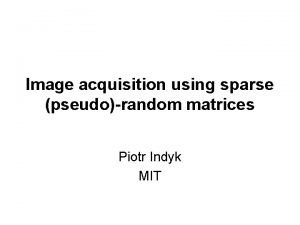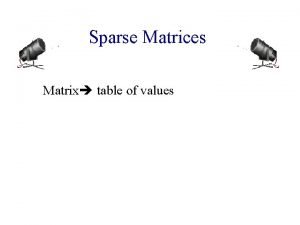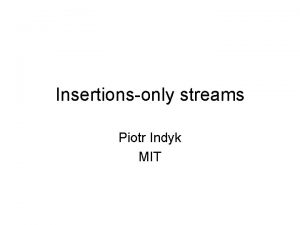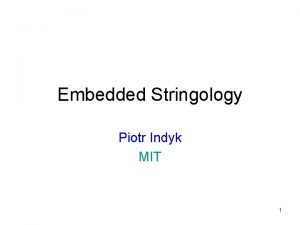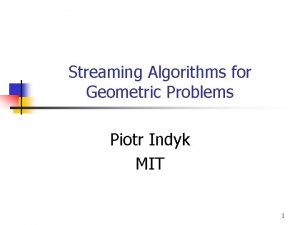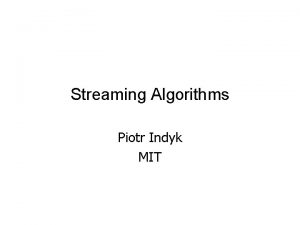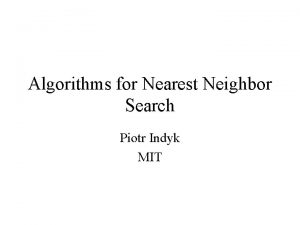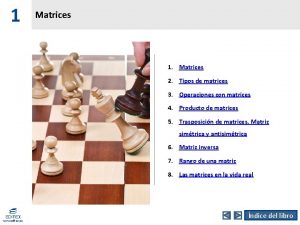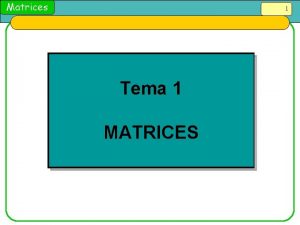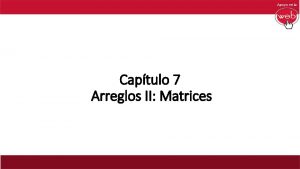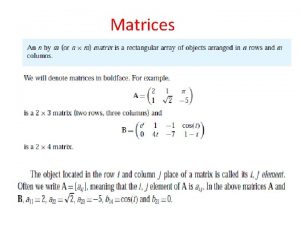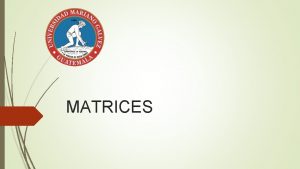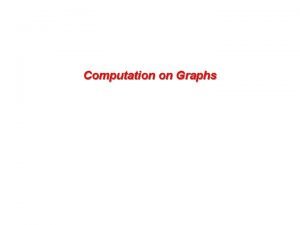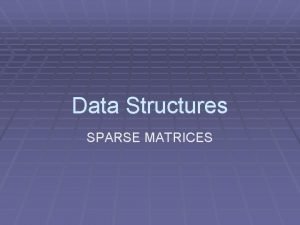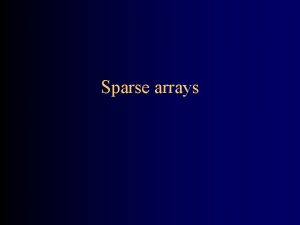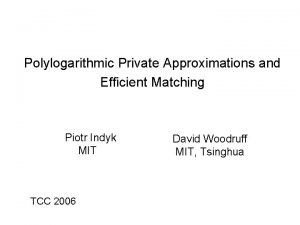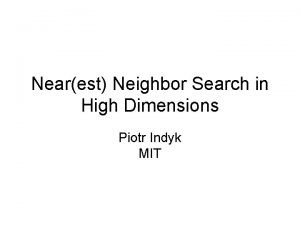Sparse Recovery Using Sparse Matrices Piotr Indyk MIT
















![dense • • vs. sparse Restricted Isometry Property (RIP) [Candes-Tao’ 04] is k-sparse || dense • • vs. sparse Restricted Isometry Property (RIP) [Candes-Tao’ 04] is k-sparse ||](https://slidetodoc.com/presentation_image_h/e7f3d75a72d5bd7f56938e5e00d5e39a/image-17.jpg)





![Sequential Sparse Matching Pursuit [Berinde-Indyk’ 09] • Algorithm: – x*=0 – Repeat T times Sequential Sparse Matching Pursuit [Berinde-Indyk’ 09] • Algorithm: – x*=0 – Repeat T times](https://slidetodoc.com/presentation_image_h/e7f3d75a72d5bd7f56938e5e00d5e39a/image-23.jpg)



- Slides: 26

Sparse Recovery (Using Sparse Matrices) Piotr Indyk MIT

Heavy Hitters • Also called frequent elements and elephants • Define HHpφ (x) = { i: |xi| ≥ φ ||x||p } • Lp Heavy Hitter Problem: – Parameters: φ and φ’ (often φ’ = φ-ε) – Goal: return a set S of coordinates s. t. • S contains HHpφ (x) • S is included in HHpφ’ (x) • Lp Point Query Problem: – Parameter: – Goal: at the end of the stream, given i, report x*i=xi ||x||p Can solve L 2 point query problem, with parameter and failure probability P by storing O(1/ 2 log(1/P)) numbers sketches [A-Gibbons-M-S’ 99], [Gilbert-Kotidis-Muthukrishnan-Strauss’ 01]

Sparse Recovery • (approximation theory, learning Fourier coeffs, linear sketching, finite rate of innovation, compressed sensing. . . ) Setup: – Data/signal in n-dimensional space : x E. g. , x is an 256 x 256 image n=65536 – Goal: compress x into a “sketch” Ax , where A is a m x n “sketch matrix”, m << n • Requirements: – Plan A: want to recover x from Ax • Impossible: underdetermined system of equations – Plan B: want to recover an “approximation” x* of x • Sparsity parameter k • Informally: want to recover largest k coordinates of x • Formally: want x* such that ||x*-x||p C(k) minx’ ||x’-x||q over all x’ that are k-sparse (at most k non-zero entries) • Want: – Good compression (small m=m(k, n)) – Efficient algorithms for encoding and recovery • Why linear compression ? A x = Ax

Application I: Monitoring Network Traffic Data Streams • Router routs packets – Where do they come from ? – Where do they go to ? Ideally, would like to maintain a traffic matrix x[. , . ] – Easy to update: given a (src, dst) packet, increment xsrc, dst – Requires way too much space! (232 x 232 entries) – Need to compress x, increment easily • Using linear compression we can: – Maintain sketch Ax under increments to x, since A(x+ ) = Ax + A – Recover x* from Ax destination source • x

Applications, ctd. • Single pixel camera [Wakin, Laska, Duarte, Baron, Sarvotham, Takhar, Kelly, Baraniuk’ 06] • Pooling Experiments [Kainkaryam, Woolf’ 08], [Hassibi et al’ 07], [Dai. Sheikh, Milenkovic, Baraniuk], [Shental-Amir. Zuk’ 09], [Erlich-Shental-Amir-Zuk’ 09]

Constructing matrix A • “Most” matrices A work – Sparse matrices: • Data stream algorithms • Coding theory (LDPCs) – Dense matrices: • Compressed sensing • Complexity/learning theory (Fourier matrices) • “Traditional” tradeoffs: – Sparse: computationally more efficient, explicit – Dense: shorter sketches • Recent results: the “best of both worlds”

Scale: Excellent Very Good Fair Results Paper R/ D Sketch length Encode time Column sparsity Recovery time Approx [CCF’ 02], [CM’ 06] R k log n n log n l 2 / l 2 R k logc n n logc n k logc n l 2 / l 2 [CM’ 04] R k log n n log n l 1 / l 1 R k logc n n logc n k logc n l 1 / l 1 [CRT’ 04] [RV’ 05] D k log(n/k) nk log(n/k) nc l 2 / l 1 D k logc n n log n k logc n nc l 2 / l 1 [GSTV’ 06] [GSTV’ 07] D k logc n n logc n k logc n l 1 / l 1 D k logc n n logc n k 2 logc n l 2 / l 1 [BGIKS’ 08] D k log(n/k) nc l 1 / l 1 [GLR’ 08] D k lognlogloglogn kn 1 -a nc l 2 / l 1 [NV’ 07], [DM’ 08], [NT’ 08], [BD’ 08], [GK’ 09], … D k log(n/k) nk log(n/k) * log l 2 / l 1 D k logc n n log n * log l 2 / l 1 [IR’ 08], [BI’ 09] D k log(n/k) n log(n/k)* log l 1 / l 1 [GLSP’ 09] R k log(n/k) n logc n k logc n l 2 / l 1 Caveats: (1) most “dominated” results not shown (2) only results for general vectors x are displayed (3) sometimes the matrix type matters (Fourier, etc)

Part I Paper R/ D Sketch length Encode time Column sparsity Recovery time Approx [CM’ 04] R k log n n log n l 1 / l 1 Theorem: There is a distribution over mxn matrices A, m=O(k logn), such that for any x, given Ax, we can recover x* such that ||x-x*||1≤ C Err 1 , where Err 1=mink-sparse x’ ||x-x’||1 with probability 1 -1/n. The recovery algorithm runs in O(n log n) time. This talk: • Assume x≥ 0 – this simplifies the algorithm and analysis; see the original paper for the general case • Prove the following l∞/l 1 guarantee: ||x-x*||∞≤ C Err 1 /k This is actually stronger than the l 1/l 1 guarantee (cf. [CM’ 06], see also the Appendix) Note: [CM’ 04] originally proved a weaker statement where ||x-x*||∞≤ C||x||1 /k. The stronger guarantee follows from the analysis of [CCF’ 02] (cf. [GGIKMS’ 02]) who applied it to Err 2

First attempt • Matrix view: – A 0 -1 wxn matrix A, with one 1 per column – The i-th column has 1 at position h(i), where h(i) be chosen uniformly at random from {1…w} 0010010 1000100001 0001000 xi • Hashing view: – Z=Ax – h hashes coordinates into “buckets” Z 1…Zw • Estimator: xi*=Zh(i) xi* Z 1 ………. . Z(4/ )k Closely related: [Estan-Varghese’ 03], “counting” Bloom filters

Analysis • We show xi* ≤ xi Err/k with probability >1/2 • Assume |xi 1| ≥ … ≥ |xim| and let S={i 1…ik} (“elephants”) • When is xi* > xi Err/k ? – Event 1: S and i collide, i. e. , h(i) in h(S-{i}) Probability: at most k/(4/ )k = /4<1/4 (if <1) – Event 2: many “mice” collide with i. , i. e. , ∑t not in S u {i}, h(i)=h(t) xt > Err/k Probability: at most ¼ (Markov inequality) • Total probability of “bad” events <1/2 x xi 1 xi 2…xik xi Z 1 ………. . Z(4/ )k

Second try • Algorithm: – Maintain d functions h 1…hd and vectors Z 1…Zd – Estimator: Xi*=mint Ztht(i) • Analysis: – Pr[|xi*-xi| ≥ α Err/k ] ≤ 1/2 d – Setting d=O(log n) (and thus m=O(k log n) ) ensures that w. h. p |x*i-xi|< α Err/k

Part II Paper R/ D Sketch length Encode time Column sparsity Recovery time Approx [CRT’ 04] [RV’ 05] D k log(n/k) nk log(n/k) nc l 2 / l 1 D k logc n n log n k logc n nc l 2 / l 1 [BGIKS’ 08] D k log(n/k) nc l 1 / l 1 [IR’ 08], [BI’ 09] D k log(n/k) n log(n/k)* log l 1 / l 1

Compressed Sensing • A. k. a. compressive sensing or compressive sampling [Candes-Romberg-Tao’ 04; Donoho’ 04] • Signal acquisition/processing framework: – Want to acquire a signal x=[x 1…xn] – Acquisition proceeds by computing Ax+noise of dimension m<<n • We ignore noise in this lecture – From Ax we want to recover an approximation x* of x • Note: x* does not have to be k-sparse in general – Method: solve the following program: minimize ||x*||1 subject to Ax*=Ax – Guarantee: for some C>1 (1) ||x-x*||1 ≤ C mink-sparse x” ||x-x”||1 (2) ||x-x*||2 ≤ C mink-sparse x” ||x-x”||1 /k 1/2

Linear Programming • Recovery: – minimize ||x*||1 – subject to Ax*=Ax • This is a linear program: – minimize ∑i ti – subject to • -ti ≤ x*i ≤ ti • Ax*=Ax • Can solve in nΘ(1) time

Intuition • LP: – minimize ||x*||1 – subject to Ax*=Ax • On the first sight, somewhat mysterious • But the approach has a long history in signal processing, statistics, etc. • Intuition: – The actual goal is to minimize ||x*||0 – But this comes down to the same thing (if A is “nice”) – The choice of L 1 is crucial (L 2 does not work) Ax*=Ax n=2, m=1, k=1

Restricted Isometry Property • A matrix A satisfies RIP of order k with constant δ if for any k-sparse vector x we have (1 -δ) ||x||2 ≤ ||Ax||2 ≤ (1+δ) ||x||2 • Theorem 1: If each entry of A is i. i. d. as N(0, 1), and m=Θ(k log(n/k)), then A satisfies (k, 1/3)-RIP w. h. p. • Theorem 2: (O(k), 1/3)-RIP implies L 2/L 1 guarantee [CRT’ 04] [RV’ 05] D k log(n/k) nk log(n/k) nc l 2 / l 1 D k logc n n log n k logc n nc l 2 / l 1
![dense vs sparse Restricted Isometry Property RIP CandesTao 04 is ksparse dense • • vs. sparse Restricted Isometry Property (RIP) [Candes-Tao’ 04] is k-sparse ||](https://slidetodoc.com/presentation_image_h/e7f3d75a72d5bd7f56938e5e00d5e39a/image-17.jpg)
dense • • vs. sparse Restricted Isometry Property (RIP) [Candes-Tao’ 04] is k-sparse || ||2 ||A ||2 C || ||2 Consider m x n 0 -1 matrices with d ones per column Do they satisfy RIP ? – No, unless m= (k 2) [Chandar’ 07] However, they can satisfy the following RIP-1 property [Berinde-Gilbert-Indyk-Karloff -Strauss’ 08]: is k-sparse d (1 - ) || ||1 ||A ||1 d|| ||1 • Sufficient (and necessary) condition: the underlying graph is a ( k, d(1 - /2) )-expander

Expanders n m • A bipartite graph is a (k, d(1 - ))-expander if for any left set S, |S|≤k, we have |N(S)|≥(1 - )d |S| • Objects well-studied in theoretical computer science and coding theory S • Constructions: N(S) d – Probabilistic: m=O(k log (n/k)) – Explicit: m=k quasipolylog n m • High expansion implies RIP-1: is k-sparse d (1 - ) || ||1 ||A ||1 d|| ||1 [Berinde-Gilbert-Indyk-Karloff-Strauss’ 08] n

Proof: d(1 - /2)-expansion RIP-1 • Want to show that for any k-sparse we have d (1 - ) || ||1 ||A ||1 d|| ||1 • RHS inequality holds for any • LHS inequality: d – W. l. o. g. assume | 1|≥… ≥| k| ≥ | k+1|=…= | n|=0 – Consider the edges e=(i, j) in a lexicographic order – For each edge e=(i, j) define r(e) s. t. m • r(e)=-1 if there exists an edge (i’, j)<(i, j) • r(e)=1 if there is no such edge • Claim 1: ||A ||1 ≥∑e=(i, j) | i|re • Claim 2: ∑e=(i, j) | i|re ≥ (1 - ) d|| ||1 n

Recovery: algorithms

L 1 minimization • Algorithm: minimize ||x*||1 subject to Ax=Ax* • Theoretical performance: – RIP 1 replaces RIP 2 – L 1/L 1 guarantee • k/m Experimental performance – Thick line: Gaussian matrices – Thin lines: prob. levels for sparse matrices (d=10) – Same performance! [BGIKS’ 08] D k log(n/k) n log(n/k) m/n log(n/k) nc l 1 / l 1

Matching Pursuit(s) A x*-x i Ax-Ax* = i • Iterative algorithm: given current approximation x* : – Find (possibly several) i s. t. Ai “correlates” with Ax-Ax*. This yields i and z s. t. ||x*+zei-x||p << ||x* - x||p – Update x* – Sparsify x* (keep only k largest entries) – Repeat • Norms: – p=2 : Co. Sa. MP, SP, IHT etc (RIP) – p=1 : SMP, SSMP (RIP-1) – p=0 : LDPC bit flipping (sparse matrices)
![Sequential Sparse Matching Pursuit BerindeIndyk 09 Algorithm x0 Repeat T times Sequential Sparse Matching Pursuit [Berinde-Indyk’ 09] • Algorithm: – x*=0 – Repeat T times](https://slidetodoc.com/presentation_image_h/e7f3d75a72d5bd7f56938e5e00d5e39a/image-23.jpg)
Sequential Sparse Matching Pursuit [Berinde-Indyk’ 09] • Algorithm: – x*=0 – Repeat T times A • Repeat S=O(k) times – Find i and z that minimize* ||A(x*+zei)-Ax||1 – x* = x*+zei i N(i) • Sparsify x* (set all but k largest entries of x* to 0) • Similar to SMP, but updates done sequentially Ax-Ax* x-x* * Set z=median[ (Ax*-Ax)N(I). Instead, one could first optimize (gradient) i and then z [ Fuchs’ 09]

Experiments 256 x 256 SSMP is ran with S=10000, T=20. SMP is ran for 100 iterations. Matrix sparsity is d=8.

Conclusions • Sparse approximation using sparse matrices • State of the art: deterministically can do 2 out of 3: – Near-linear encoding/decoding This talk – O(k log (n/k)) measurements – Approximation guarantee with respect to L 2/L 1 norm • Open problems: – 3 out of 3 ? – Explicit constructions ?

References • Survey: A. Gilbert, P. Indyk, “Sparse recovery using sparse matrices”, Proceedings of IEEE, June 2010. • Courses: – “Streaming, sketching, and sub-linear space algorithms”, Fall’ 07 – “Sub-linear algorithms” (with Ronitt Rubinfeld), Fall’ 10 • Blogs: – Nuit blanche: nuit-blanche. blogspot. com/
 Piotr indyk
Piotr indyk Piotr indyk
Piotr indyk Piotr indyk
Piotr indyk Direct methods for sparse linear systems
Direct methods for sparse linear systems Datar-gionis-indyk-motwani algorithm
Datar-gionis-indyk-motwani algorithm Datar-gionis-indyk-motwani
Datar-gionis-indyk-motwani Wiersz wesołe zoo
Wiersz wesołe zoo On single image scale-up using sparse-representations
On single image scale-up using sparse-representations Transformations using matrices
Transformations using matrices 3-6 solving systems using matrices
3-6 solving systems using matrices Symmetric relation
Symmetric relation Discrete structure
Discrete structure Sparse conditional constant propagation
Sparse conditional constant propagation Keuntungan dari sparse array adalah
Keuntungan dari sparse array adalah Sparse matrix operator kernel emissions
Sparse matrix operator kernel emissions Dmspy
Dmspy Sparse matrix
Sparse matrix Sparse conditional constant propagation
Sparse conditional constant propagation Dense index vs sparse index
Dense index vs sparse index Sparse matrix in data structure
Sparse matrix in data structure Sparse pca
Sparse pca Sparse matrix in data structure
Sparse matrix in data structure Dante e petrarca a confronto
Dante e petrarca a confronto Efficient sparse voxel octrees
Efficient sparse voxel octrees Arid region with sparse to almost noneexistent vegetation
Arid region with sparse to almost noneexistent vegetation Uncentered commercial (strip) development
Uncentered commercial (strip) development Sparse solution
Sparse solution
